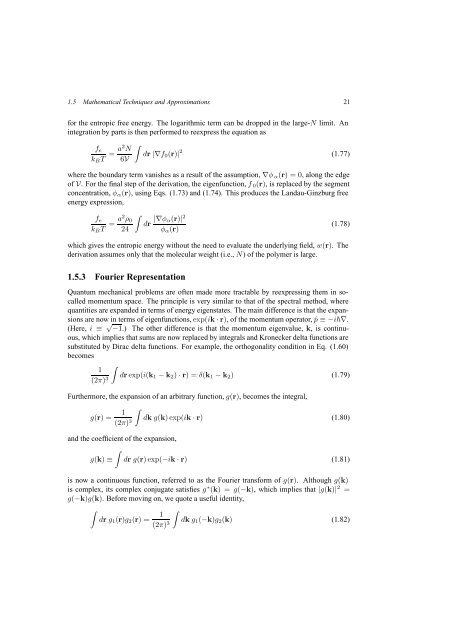Self-Consistent Field Theory and Its Applications by M. W. Matsen
Self-Consistent Field Theory and Its Applications by M. W. Matsen
Self-Consistent Field Theory and Its Applications by M. W. Matsen
Create successful ePaper yourself
Turn your PDF publications into a flip-book with our unique Google optimized e-Paper software.
1.5 Mathematical Techniques <strong>and</strong> Approximations 21<br />
for the entropic free energy. The logarithmic term can be dropped in the large-N limit. An<br />
integration <strong>by</strong> parts is then performed to reexpress the equation as<br />
∫<br />
f e<br />
k B T = a2 N<br />
dr |∇f 0 (r)| 2 (1.77)<br />
6V<br />
where the boundary term vanishes as a result of the assumption, ∇φ α (r) =0, along the edge<br />
of V. For the final step of the derivation, the eigenfunction, f 0 (r), is replaced <strong>by</strong> the segment<br />
concentration, φ α (r), using Eqs. (1.73) <strong>and</strong> (1.74). This produces the L<strong>and</strong>au-Ginzburg free<br />
energy expression,<br />
∫<br />
f e<br />
k B T = a2 ρ 0<br />
24<br />
dr |∇φ α(r)| 2<br />
φ α (r)<br />
(1.78)<br />
which gives the entropic energy without the need to evaluate the underlying field, w(r). The<br />
derivation assumes only that the molecular weight (i.e., N) of the polymer is large.<br />
1.5.3 Fourier Representation<br />
Quantum mechanical problems are often made more tractable <strong>by</strong> reexpressing them in socalled<br />
momentum space. The principle is very similar to that of the spectral method, where<br />
quantities are exp<strong>and</strong>ed in terms of energy eigenstates. The main difference is that the expansions<br />
are now in terms of eigenfunctions, exp(ik · r), of the momentum operator, ˆp ≡−i∇.<br />
(Here, i ≡ √ −1.) The other difference is that the momentum eigenvalue, k, is continuous,<br />
which implies that sums are now replaced <strong>by</strong> integrals <strong>and</strong> Kronecker delta functions are<br />
substituted <strong>by</strong> Dirac delta functions. For example, the orthogonality condition in Eq. (1.60)<br />
becomes<br />
∫<br />
1<br />
(2π) 3 dr exp(i(k 1 − k 2 ) · r) =δ(k 1 − k 2 ) (1.79)<br />
Furthermore, the expansion of an arbitrary function, g(r), becomes the integral,<br />
g(r) = 1 ∫<br />
(2π) 3 dk g(k)exp(ik · r) (1.80)<br />
<strong>and</strong> the coefficient of the expansion,<br />
∫<br />
g(k) ≡ dr g(r)exp(−ik · r) (1.81)<br />
is now a continuous function, referred to as the Fourier transform of g(r). Although g(k)<br />
is complex, its complex conjugate satisfies g ∗ (k) =g(−k), which implies that |g(k)| 2 =<br />
g(−k)g(k). Before moving on, we quote a useful identity,<br />
∫<br />
dr g 1 (r)g 2 (r) = 1 ∫<br />
(2π) 3 dk g 1 (−k)g 2 (k) (1.82)
















